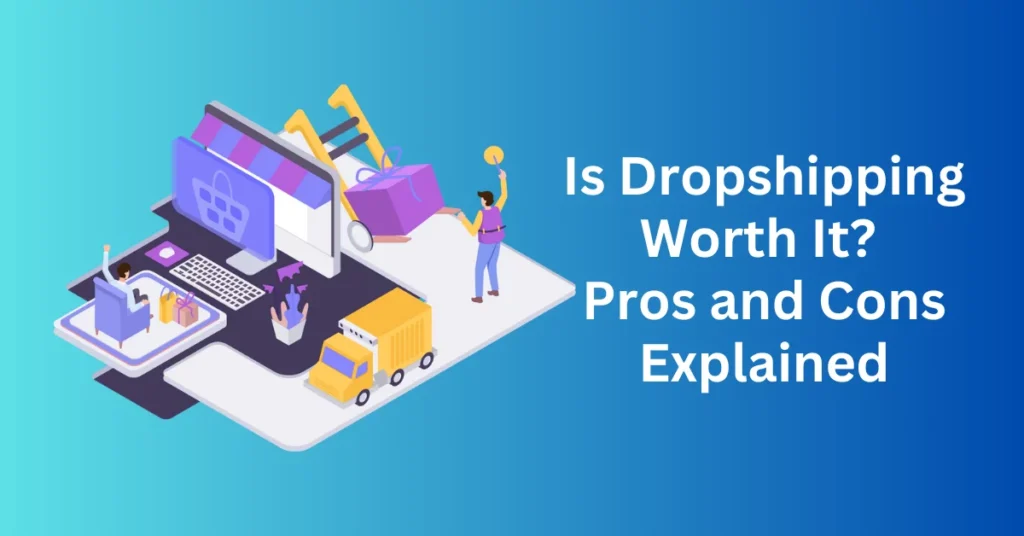The dropshipping business model has emerged as a favoured strategy in eCommerce. It provides a distinct method of online selling that sidesteps the complexities of inventory management and supply chain logistics. Instead, it prioritizes store management, branding, and marketing as the core operational pillars.
As with any business approach, dropshipping boasts a range of advantages and weaknesses. Let’s start a detailed analysis of the pros and cons to decide whether this model harmonizes with your entrepreneurial aspirations.
What Is Dropshipping?
Dropshipping represents a streamlined and innovative retail approach that has revolutionized how entrepreneurs engage in online product sales. Unlike traditional retail models, dropshipping does not involve maintaining inventory or order fulfillment.

Here’s how dropshipping operates: When a customer makes a purchase from a dropshipping store, the retailer buys the product from a third-party supplier—often a wholesaler or manufacturer—and arranges for it to be shipped directly to the customer. The retailer profits from the difference between the sale price and the supplier’s price.
For instance, consider a dropshipper who collaborates with a manufacturer through a platform like AliExpress to market their products on eBay. When a customer buys one of their product, the dropshipper places an order with the manufacturer. They then ships the product directly to the customer.
In this scenario, the dropshipper avoids the logistical challenges of managing inventory and fulfillment, streamlining the sales process. However, it also means relying on external suppliers’ quality standards.
The appeal of dropshipping lies in its low-risk nature. In addition, this business model has gained immense popularity alongside the growth of eCommerce. With the dropshipping market projected to reach $287.36 billion in revenue by 2023, it’s expected to surge to a staggering $1.253 trillion by the decade’s end.
Starting a dropshipping venture requires minimal investment. All you need is an eCommerce platform or website, partnerships with reliable suppliers, and an effective digital marketing strategy. Due to its low startup costs and operational flexibility, dropshipping serves as an attractive model for aspiring eCommerce entrepreneurs.
Start your Print-on-demand Dropshipping Business Now
Pros of Dropshipping
Dropshipping offers distinct advantages that make it an appealing choice for aspiring entrepreneurs exploring eCommerce. Let’s get into the benefits dropshipping model for your online store, from setup to operational aspects like order fulfillment.
Ease of Getting Started
Compared to traditional retail models that necessitate warehouse space and upfront inventory investment, dropshipping offers a revolutionary approach. In a dropshipping eCommerce setup, you can showcase products sourced directly from suppliers and start selling immediately.
This methodology significantly diminishes the financial obstacles typically associated with starting a retail business, rendering it, particularly appealing to new entrepreneurs. The flexibility of dropshipping empowers you to experiment with diverse markets and product categories without enduring long-term commitments.
For instance, you can seamlessly transition from selling phone cases to offering home decor items, exploring various niches and responding swiftly to market dynamics. This agility and lack of binding commitments enable you to refine your business strategy and capitalize on emerging opportunities efficiently.
Low Investments
Launching a dropshipping business demands less initial investments than traditional store. The core advantage of this model rests in its modest financial requisites. Besides, it’s primarily centred around leveraging eCommerce platforms and marketing your brand effectively.
This reduced financial barrier enables a broader demographic to enter the online selling space with minimal risk. In addition, the funds saved on inventory and warehouse expenses can be channelled into expansive marketing campaigns, bolstering the visibility and reach of your virtual storefront.
By requiring less upfront capital, dropshipping democratizes entrepreneurship. It empowers individuals with varying financial resources to embark on their eCommerce journey. This accessibility fosters innovation and market diversity. It facilitates the emergence of new businesses and fostering economic growth within the digital landscape.
Flexible Product Pricing
Dropshipping provides remarkable flexibility when it comes to product pricing. Freed from the logistical constraints, overhead costs, and the need for extensive personnel, you can readily adjust prices to align with market trends and consumer preferences, thereby optimizing profit margins.
This adaptability in pricing allows you to offer enticing deals on trending items and seasonal must-haves swiftly and efficiently. Therefore, you can remain responsive to the dynamic eCommerce landscape without being bound by the rigid structures typical of traditional business.
The ability to promptly modify pricing strategies in response to market fluctuations and buyer behaviour not only enhances profitability but also ensures that your brand remains competitive and appealing to online shoppers. This flexibility is a key advantage that empowers dropshipping businesses to thrive in the ever-evolving digital marketplace.
Diverse Selection of Goods
One of the standout features of dropshipping is the access to a wide array of non-local products offered by numerous shipping companies and wholesalers. This diversity enables your store to stand out from traditional retailers and other dropshipping businesses. With thorough supplier research, you can strategically plan and cater to any customer demographic.
Whether it’s high-fashion accessories or the latest gadgets, dropshipping aligns closely with consumer trends, allowing you to swiftly respond to market shifts. This agility outpaces traditional retail models, ensuring your store remains dynamic, fresh, and relevant. The flexibility to modify and adapt product offerings easily is a significant advantage in keeping pace with evolving consumer preferences and market demands.
Global Sourcing
Dropshipping unlocks the potential for global sourcing. It enables partnerships with suppliers from various corners of the world and expands your reach to customers worldwide. The competitive landscape among suppliers and dropshippers fosters a commitment to maintaining high standards in order processing and product quality.
This approach differs significantly from traditional reselling, which often restricts businesses to locally available products. Unlike the limitations imposed by regional warehouses, dropshipping offers a wealth of options and diversity in product quality. While not all suppliers or warehouses may offer identical product standards, the abundance of choices enriches the purchasing experience for customers, contributing to a more varied and appealing marketplace.
Minimal Risk
The dropshipping business model inherently presents a lower risk of profit loss compared to traditional retail methods. By eliminating the need for upfront investments in inventory management and associated hassles, dropshipping mitigates financial risks related to unsold stock or unpaid bills.
This low-risk environment is particularly advantageous for entrepreneurs looking to test different markets and products. It allows for experimentation with new items without the fear of significant financial losses. While dropshipping requires planning and effort like any other business, the minimal costs associated with this model help minimize potential setbacks.
In essence, dropshipping offers a safety net against the uncertainties commonly faced in retail, making it an appealing choice for those seeking to explore entrepreneurial ventures with reduced financial exposure and increased flexibility.
Start your Print-on-demand Dropshipping Business Now
Cons of Dropshipping
Let’s follow along with some of the setbacks and issues with dropshipping compared to traditional retail methods that many businesses consider when balancing the positives.
Lack of Customization and Branding
A significant drawback of dropshipping is the limited opportunity for unique product customization and branding. Since products are sourced directly from dropshipping suppliers, they often lack distinct branding elements crucial for establishing a company’s identity and visual theme.
This limitation can pose challenges for businesses aiming to build a strong brand presence. Besides, competing with other sellers offering the exact same products under different brand names can hinder efforts to differentiate and carve out a unique market position.
However, this challenge can be addressed through custom product services. Some dropshipping suppliers offer options for customizing products with unique branding, packaging, or labelling. This allows you to add personalized touches that align with your brand identity.
For entrepreneurs committed to creating their own brand, it’s essential to carefully select suppliers that offer customization options or consider partnering with manufacturers who can accommodate bespoke product designs. While overcoming this hurdle requires additional effort and investment, it can ultimately help differentiate your business and foster brand loyalty among customers.
Competing on Low-Profit Margins
Dropshipping, despite its low startup costs, frequently entails lower profit margins due to competition. This is particularly true in highly saturated niches where multiple dropshipping businesses offer similar products. This intense competition often drives prices down, squeezing profit margins and presenting challenges for new market entrants.
In such competitive landscapes, maintaining profitability requires effective sales strategies and possibly exploring alternative suppliers. By implementing innovative marketing tactics, such as targeted advertising, content marketing, or influencer partnerships, businesses can differentiate themselves and attract customers despite pricing pressures.
Furthermore, diversifying product offerings or seeking out suppliers with competitive pricing and quality can help optimize profit margins. Some entrepreneurs opt to focus on niche markets or unique product variations to reduce direct competition and command higher prices.
Ultimately, succeeding in dropshipping demands proactive adaptation to market dynamics, constant optimization of sales strategies, and strategic supplier management to navigate challenges and sustain healthy profit margins in the face of fierce competition.
Limited Control Over Product Quality
A notable downside of the dropshipping business model is the lack of control over product quality. Since products are sourced and shipped directly by third-party suppliers, you heavily depend on these suppliers to ensure product quality.
This reliance on suppliers can lead to inconsistencies in product quality across listings, potentially resulting in customer dissatisfaction and increased return rates. Maintaining consistent quality is paramount for building and preserving brand reputation in the competitive eCommerce landscape, making the selection of reliable dropshipping suppliers crucial.
To address this challenge, you must carefully vet and establish partnerships with reputable suppliers known for their commitment to quality control. Regular communication with suppliers, setting clear quality standards, and conducting periodic quality checks can help mitigate risks associated with inconsistent product quality.
Additionally, some dropshippers opt for suppliers with proven track records and positive customer feedback to minimize quality-related issues. By prioritizing supplier reliability and quality assurance protocols, businesses can enhance customer satisfaction, reduce return rates, and safeguard their brand reputation within the dropshipping ecosystem.
Challenges in Providing Effective Customer Service

Dropshipping companies frequently encounter challenges related to shipping estimates and managing returns. Since the shipping process is entirely managed by third-party suppliers, dropshipping stores may face delays and logistical issues that directly impact the customer experience.
The lack of direct control over shipping can result in inaccurate delivery estimates, leading to customer dissatisfaction and potential order cancellations. To mitigate this, dropshippers should work closely with reliable suppliers who can provide accurate shipping information and expedite order processing.
Handling returns is another area of concern for dropshipping businesses. Resolving return requests efficiently requires effective communication and coordination between the dropshipper, supplier, and customer. Managing these interactions can be complex, especially when dealing with sales orders fulfilled by multiple suppliers.
To address these challenges, dropshippers can implement the following strategies:
- Select Reliable Suppliers: Partner with suppliers known for their shipping reliability and customer service. Establish clear communication channels and expectations regarding shipping estimates and return policies.
- Use Shipping Tracking: Provide customers with tracking information so they can monitor the status of their orders. This transparency helps manage expectations and reduce inquiries related to shipping delays.
- Implement Clear Return Policies: Define and communicate clear return policies to customers. Streamline the return process by facilitating direct communication between customers and suppliers to expedite refunds or replacements.
- Centralize Communication: Utilize centralized communication tools or platforms to manage interactions between the dropshipper, suppliers, and customers. This helps streamline communication and resolve issues promptly.
- Monitor Performance: Regularly assess supplier performance and customer feedback related to shipping and returns. Address any recurring issues by proactively working with suppliers to improve service quality.
By proactively managing shipping estimates, return processes, and communication channels, dropshipping businesses can enhance the overall customer experience and mitigate challenges associated with third-party logistics management.
Start your Print-on-demand Dropshipping Business Now
Tips for Successful Dropshipping
Find a Reliable Dropshipping Supplier
Finding and establishing partnerships with reliable third-party suppliers is crucial for addressing challenges and ensuring the success of a dropshipping business. Working with reputable suppliers that offer quality products and dependable shipping services can significantly enhance credibility and contribute to long-term customer satisfaction.
Here are key steps to vet and collaborate with reliable dropshipping suppliers effectively:
Supplier Reputation:
You must conduct thorough research on potential suppliers. To do this, you can utilize online platforms like Reddit, Trustpilot, and industry-specific directories to gather reviews, testimonials, and feedback on their service, product quality, and reliability. Then, look for suppliers with a track record of positive customer experiences and consistent performance.
Communication and Support:
Evaluate the supplier’s responsiveness and support services. A reliable supplier should offer clear, timely communication and responsive support to address any inquiries or issues that may arise during the partnership.
Order Product Samples:
Before committing to a supplier, order samples of their products. This will then allow you to assess product quality, packaging, and shipping times firsthand. You need to ensure that they meet your standards and align with your brand’s quality expectations.
Understand Their Policies:
Familiarize yourself with the supplier’s policies on shipping, returns, and handling of potential issues. Besides, you need to ensure their policies align with your customer service standards and provide clarity on how they manage order fulfillment and customer inquiries.
Check for Integration Capability:
Ensure the supplier’s system seamlessly integrates with your eCommerce platform. Compatibility and integration capabilities are essential for streamlining order management, inventory tracking, and data synchronization between your store and the supplier’s system.
By following these steps and establishing strong partnerships with reliable suppliers, dropshipping businesses can mitigate risks associated with product quality, shipping delays, and customer service issues. Investing time in supplier research and due diligence upfront can pay off in the form of improved operational efficiency, enhanced customer experiences, and sustained business growth in the competitive dropshipping landscape.
Conduct Comprehensive Market Research

Understanding the market and your target audience is essential for success in dropshipping, especially given its competitive nature. Besides, conducting regular and detailed market research enables you to identify trends, understand customer preferences, and uncover market gaps that can be effectively addressed.
Here are actionable steps to enhance your market understanding and leverage insights for your dropshipping business:
- Identify Your Niche: Focus on a specific market segment that aligns with your interests and exhibits a viable audience. Conduct a thorough analysis to identify trends, demands, and untapped market opportunities within your chosen niche.
- Analyze Competitors: Study your competitors extensively to gain insights into their strategies, product offerings, pricing models, and customer service approaches. Identify areas where you can differentiate your store and offer unique value propositions to attract and retain customers.
- Gather Customer Insights: Utilize various tools such as surveys, social media platforms, and online forums to gather insights into potential customers’ needs, preferences, and purchasing behavior. Use this data to tailor your product offerings, marketing strategies, and customer interactions accordingly.
- Monitor Industry Trends: Stay informed about industry trends, market developments, and emerging products within your niche. Attend trade shows, participate in webinars, and follow relevant blogs and news sources to stay abreast of the latest developments. This knowledge will enable you to adapt quickly and capitalize on new opportunities.
By proactively conducting market research and leveraging customer insights, you can position your dropshipping business for success in a competitive landscape. Understanding your niche, analyzing competitors, and staying informed about market trends are essential steps toward building a thriving and resilient dropshipping venture. Adaptability and responsiveness to market dynamics will be key to sustaining growth and effectively meeting the evolving needs of your target audience.
Start your Print-on-demand Dropshipping Business Now
Create a Strong Brand and Marketing Strategy
Building a strong brand and implementing an effective marketing strategy are essential components for success in dropshipping, especially when product differentiation can be challenging due to market saturation.
Here’s how you can establish a distinctive brand identity and leverage marketing strategies to set your business apart from competitors:
1. Define Your Brand Identity
Start by establishing a clear and compelling brand identity that encapsulates your brand’s mission, values, and aesthetic. Then, define what sets your brand apart and resonates with your target audience. You need to craft a unique selling proposition (USP) that highlights the value you offer compared to competitors.
2. Optimize Your Online Presence
Ensure that your website and social media channels reflect your brand identity consistently. Use high-quality visuals, cohesive messaging, and a user-friendly design that enhances the overall customer experience. Make it easy for customers to navigate your site and understand your brand story.
3. Develop a Content Marketing Plan
Create and share valuable content related to your niche to engage and educate your audience. Develop a content marketing strategy that includes blog posts, tutorials, product reviews, and user-generated content. Position yourself as an authority in your niche by providing useful information and addressing customer pain points.
4. Leverage Social Media Channels
Utilize social media platforms to connect with your target audience and build brand awareness. Tailor your content to each platform and engage with followers regularly. Collaborate with influencers who align with your brand values and have a relevant audience to expand your reach and credibility.
5. Implement Email Marketing
Build and nurture relationships with your customers through email marketing campaigns. Use personalized messaging and targeted offers to drive sales and encourage repeat business. Collect customer feedback and use it to refine your product offerings and improve the overall customer experience.
6. Offer Excellent Customer Service
Provide exceptional customer service to build trust and loyalty. Respond promptly to inquiries and resolve issues promptly and professionally. Positive customer experiences can lead to repeat business and positive word-of-mouth referrals.
By focusing on building a strong brand identity and implementing a comprehensive marketing strategy, you can differentiate your dropshipping business in a competitive market. Establishing a unique brand voice, optimizing your online presence, and engaging with your audience through valuable content and social media interactions will help attract and retain customers, ultimately driving business growth and success.
Start your Print-on-demand Dropshipping Business Now
Use Print on Demand for Customization and Profit
For dropshipping businesses seeking to offer customized products, integrating Print on Demand (POD) services can be a lucrative addition that enhances competitiveness and customer satisfaction.
Here’s how to leverage POD effectively within your dropshipping model:
1. Offer Personalized Products: Partner with reputable POD services to access integrated fulfillment options and offer a diverse range of personalized products to your customers. Capitalize on the growing demand for customized items, such as apparel, accessories, and home decor, to attract and retain a loyal customer base.
2. Create Unique Designs: Stand out in the market by offering exclusive designs that cater to your niche audience. Utilize POD design tools and resources to create branded products that resonate with your target demographic. Focus on developing visually appealing and on-trend designs that capture the essence of your brand identity.
3. Test and Refine Customization: Continuously experiment with new product ideas and designs to gauge customer interest and preferences. Leverage customer feedback and sales data to refine your customization offerings, ensuring they align with audience expectations and market trends. Stay adaptable and responsive to evolving consumer tastes.
4. Market Your Unique Selling Proposition (USP): Showcase the customization capabilities and product quality of your POD offerings in your marketing campaigns. Highlight the benefits of personalized products, such as uniqueness and attention to detail, to differentiate your brand from competitors. Utilize customer testimonials and product reviews to build credibility and instill confidence in potential buyers.
What Is the Difference Between Dropshipping and Print on Demand?
Dropshipping and Print-on-Demand (POD) are distinct eCommerce business models, each offering unique advantages and catering to different customer preferences and market segments:
| Aspect | Dropshipping | Print-on-Demand (POD) |
| Product Sourcing | Pre-made items sourced from various suppliers | Custom-printed products produced upon customer order |
| Inventory & Customization | No upfront inventory; Limited customization options | No inventory; Extensive product customization |
| Supplier Relationship | Work with multiple suppliers offering diverse products | Work closely with specialized printing suppliers |
| Profit Margins | Slim due to competition and standardized products | Higher margins due to unique, personalized offerings |
| Target Market | Broad market appeal; Mainstream product offerings | Niche-focused; Appeals to customers seeking personalized items |
Both dropshipping and POD offer accessible entry points into eCommerce without the need for managing inventory or shipping logistics independently. The choice between these models depends on your business goals, target market preferences, and desired level of product customization. Whether you aim to serve a broad audience with diverse product offerings (dropshipping) or cater to a niche market seeking personalized items (POD), understanding the unique attributes of each model is essential for making informed decisions and maximizing business success in the evolving eCommerce landscape.
Start your Print-on-demand Dropshipping Business Now
Final Thoughts: Is Dropshipping Worth It? Pros and Cons Explained
Embarking on a dropshipping venture presents a spectrum of opportunities and challenges. On the positive side, dropshipping provides an accessible gateway into e-commerce with minimal financial risk and an extensive array of products to offer customers. However, this convenience comes hand in hand with heightened competition and the potential for limitations in customer service capabilities.
To craft a robust e-commerce strategy, it’s crucial to delve deeper into the advantages and disadvantages of dropshipping. By understanding these dynamics thoroughly, you can navigate this business model effectively.
When commencing your dropshipping journey, selecting a reliable supplier is paramount. Consider partnering with Printify, a trusted product sourcing provider that offers an all-encompassing print-on-demand dropshipping service. By leveraging Printify’s global network of Print Providers, you gain access to a diverse range of products without any upfront costs.
One notable advantage of using Printify is the ability to cultivate a distinct brand identity through custom products. Tailor your offerings to align seamlessly with your brand’s aesthetic and message, enhancing customer engagement and loyalty.
Furthermore, Printify facilitates effortless integration with leading e-commerce platforms and marketplaces. This seamless connectivity streamlines operations, allowing you to focus on scaling your business and expanding your market reach.
In summary, embarking on the dropshipping journey with Printify empowers you to leverage the benefits of this business model while mitigating its inherent challenges. Build a strong foundation for your e-commerce enterprise by embracing quality sourcing and innovative branding strategies. By doing so, you position yourself for sustained success in the competitive online marketplace.


